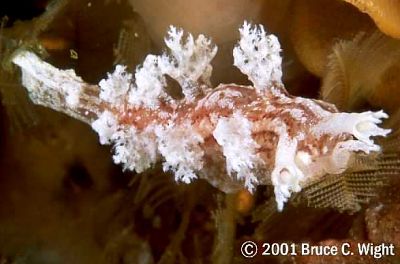
Dendronotus subramosus
MacFarland, 1966
Order: NUDIBRANCHIA
Suborder: DENDRONOTINA
Family: Dendronotidae
DISTRIBUTION
Los Coronados Islands, Baja California to San Juan Channel, B.C. Canada.
PHOTO
San Miguel Island, Channel Ids, California, 27 July 2001. approx 65 feet. on Aglaophenia. Photos: Bruce Wight.
The general background colour of the animal varies from translucent brown through to yellow, orange or dark brown. The colour can be uniform with no patterning or there can be small scattered lemon-yellow spots, or spots of dark brown, reddish brown, or green, or white, or a combination of these. There can also be brown longitudinal lines.
The pallial margin of head is rounded with a series of four to six stout branched processes, the two nearest the mid-line on either side usually the largest, the next somewhat smaller, and the outermost, when present being little more than small tubercles. The largest of these processes bear short blunt branches given off at a sharp angle to the main stalk; the smaller outer processes usually being unbranched. The rhinophore stalk is smooth, lacking any of the basal external processes found in other species of the genus. The sheath, at the top of the rhinophore stalk bears five to seven short blunt processes, the longest on the rear margin, the others progressively shorter toward the front of the sheath edge. The largest of these processes may bear one or more short blunt tubercle-like branches. There are usually six pairs, of branching dorso-lateral papillae along the mantle edge. The anus opens dorso-laterally about midway between the first and second dorsal papillae of the right side. Most reports suggest it feeds exclusively on hydroids of the genus Aglaophenia
References:
• Farmer, W.M. (1980). Sea-slug gastropods. W.M.Farmer Enterprises, Inc. Tempe, AZ, USA.
• MacFarland, F.M. (1966). Studies of Opisthobranchiate Mollusks of the Pacific Coast of North America. Memoirs of the California Academy of Sciences, VI: 546pp.
• Robilliard, G. A. (1970) The systematics and some aspects of the ecology of the genus Dendronotus. The Veliger, 12(4): 433-479, pls. 63-64.
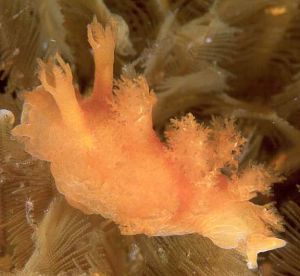
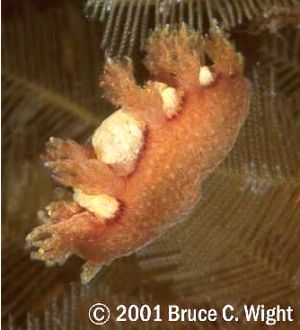
Rudman, W.B., 2003 (July 30) Dendronotus subramosus MacFarland, 1966. [In] Sea Slug Forum. Australian Museum, Sydney. Available from http://www.seaslugforum.net/find/dendsubr
Related messages
Dendronotus subramosus at work
June 4, 2007
From: Jan Kocian
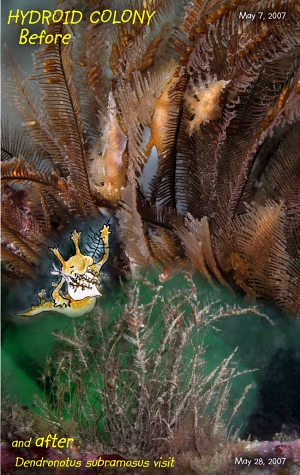
Don't hire these guys to tend your HYDROidPONIC garden. :)
Jan Kocian
honkoc@hotmail.com
Kocian, J., 2007 (Jun 4) Dendronotus subramosus at work. [Message in] Sea Slug Forum. Australian Museum, Sydney. Available from http://www.seaslugforum.net/find/19970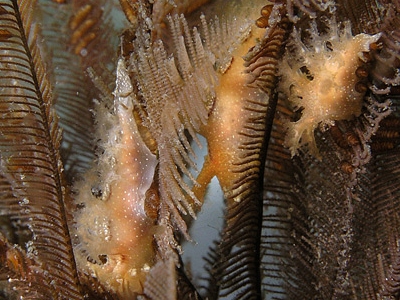
Dear Jan,
I hope you don't mind me posting this on the Forum - it's a perfect biology lesson. For many nudibranchs like D. subramosus, life is very precarious - one minute a feast, the next a famine.
Thanks for injecting a bit of humour,
Bill Rudman
Mystery slug from Cannon Beach, Oregon
January 12, 2007
From: Minette Layne
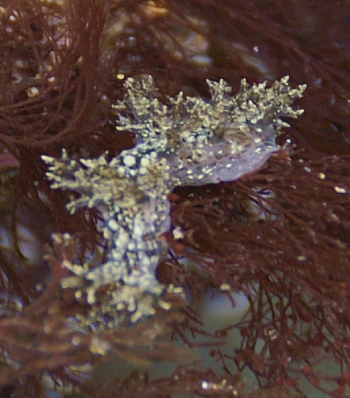
Dear Sea Slug Forum,
I saw this nudibranch in a tide pool this summer while at Cannon Beach, Oregon, USA, and am having a difficult time identifying it.
I thought perhaps it was Dendronotus frondosus, but felt uncertain about that because it doesn't look the same (to me) as the photographs of D. frondosus I found on the forum. The rhinophores, in particular, seem a bit different from what I'm seeing in the other pictures.
I know the picture quality is poor and so this might remain a mystery forever. But I'd be most grateful if someone can help me identify this critter.
Locality: Cannon Beach, In a tide pool, Oregon, USA, Pacific Ocean, April 29, 2006, Intertidal. Length: 1/2 inch. Photographer: Minette Layne.
All the best,
Minette Layne
Seattle, Washington, USA
minette_layne@hotmail.com
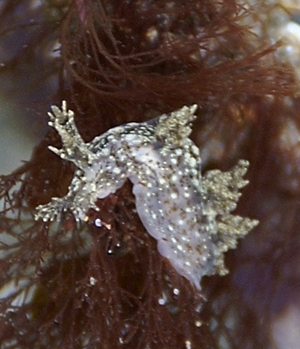
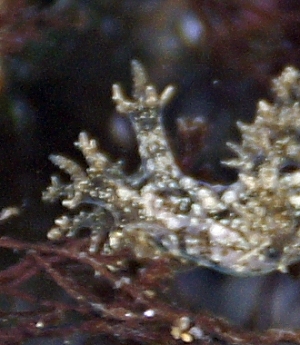
Hi Minette:
This critter is pretty rare. It is Dendronotus subramosus. The rhinophoral crown papillae are what I use to ID this species, which can be easily confused with both Dendronotus frondosus and Hancockia californica (the latter is a more southern species). Note that in your specimen, the papillae on the rhinophoral crown are short and blunt, and there are no lateral rhinophoral processes. In D. frondosus the crown papillae are branched. In both the color varies widely.
Hope this helps.
Dave
Dendronotus subramosus from Monterey, California
January 27, 2006
From: Clinton Bauder
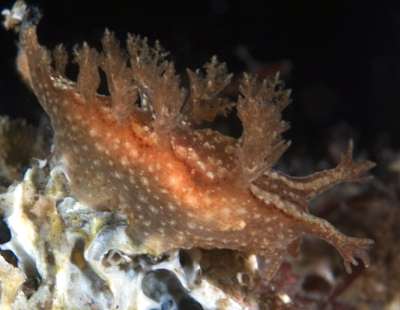
Hi Bill,
This critter was on the same hydroid as the Dotos in my earlier message [#15117 ] but it fell off during the photo shoot so the pictures aren't on the presumed food item.
Locality: Monterey Breakwater, California, USA. Depth: 10 meters. Length: 20 mm. 22 October 2005. Hydroid on a rocky breakwater. Photographer: Michael Jimenez
Since my previous messages proved I can't tell Dendronotus subramosus and D. frondosus apart I'm reluctant to make a definitive statement but I have a hunch this one might be D. subramosus. The rhinophores are smooth all the way out to the crown at the end and I think the hydroid is the right food source. In any case we shot this guy at several different angles so hopefully the pictures provides the details needed for ID. Photos were taken by my friend Mike Jimenez.
Clinton
gecko1@apple.com
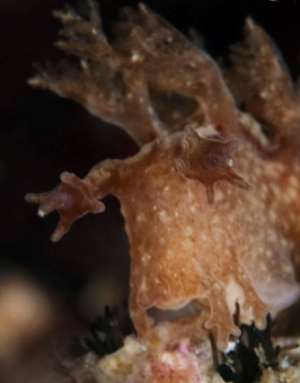
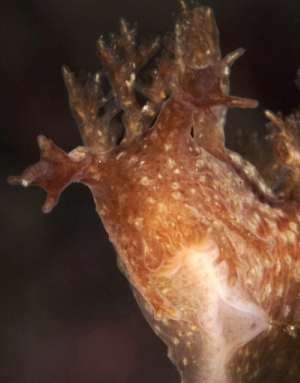
Hi Clinton,
Well I would definitely have to go with Dendronotus subramosus MacFarland, 1966. The smooth body, smooth rhinophores and branched processes on the frontal veil are perfect. The color of Mike's specimen is also very characteristic.
Best wishes,
Dave Behrens
Dendronotus subramosus - Take 2
September 15, 2005
From: Clinton Bauder
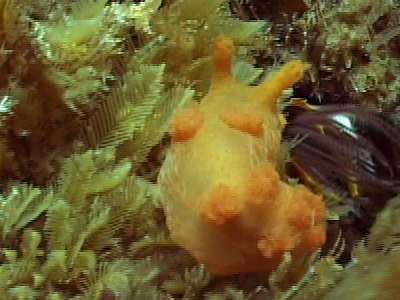
Hi Bill,
After some back and forth with Dave Behrens (who thinks the animal in my previous message (#14245) might be D. frondosus instead) I have another D. subramosus candidate for you. This one is from the Farallon Islands near San Francisco at the very top of a pinnacle called Noonday Rock. This one actually does have the prey hydroid. (sorry to mislead you in the other message)
Locality: Noonday Rock, Farallon Islands, California, USA. Depth: 10 meters. Length: 20 mm. 9 May 2004. Rocky Pinnacle. Photographer: Clinton Bauder
Also unlike the other image this one is from my video camera and thus of somewhat limited quality.
Clinton
gecko1@apple.com
Bauder, C., 2005 (Sep 15) Dendronotus subramosus - Take 2. [Message in] Sea Slug Forum. Australian Museum, Sydney. Available from http://www.seaslugforum.net/find/14771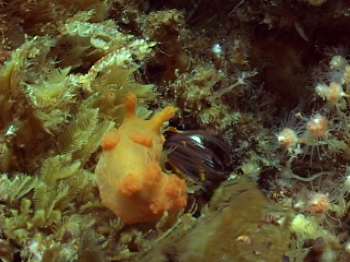
Dear Clinton,
Thanks for this photo, and thanks for following the earlier one up with Dave Behrens, whose message [#14770] I'm posting today as well. As he says ... sometimes the animal wins.
Best wishes,
Bill Rudman
Dendronotus subramosus? from California
March 23, 2004
From: Sean Kearney
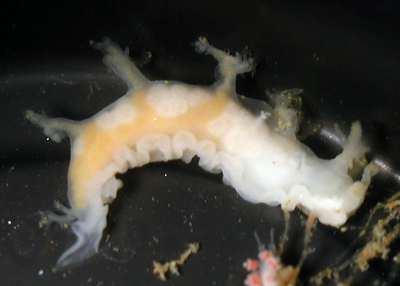
Dear Bill
Following my last message [#12493], here are photos of the other mystery animal which I think might be a Dendronotus?. It was also found in 65fsw off of Pt. Loma, San Diego, California. [March 2004].
It was in the hydroids near the Doto and Flabellina.
Thanks again.
Love your Forum.
Sean Kearney
skearney@dc.rr.com
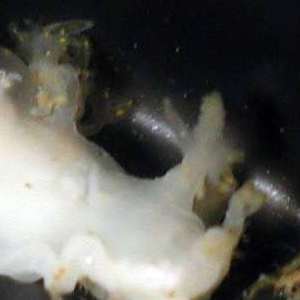
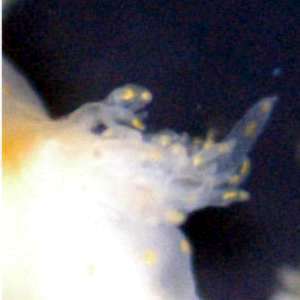
Dear Sean
From the small Doto in the foreground of the upper photo this is a much larger animal than the others. It is certainly in a bad shape but it certainly has 'cerata' which fit Dendronotus and papillae around the edge of the rhinophore sheath. I have no personal knowledge of the Californian species but I read that Dendronotus subramosus is very variable in colour and has a translucent white colour form with yellow spots which would seem to fit your animal. Hopefully someone can confirm this id or suggest a better one
Best wishes
Bill Rudman
Mystery slug is Dendronotus subramosus
August 9, 2003
From: Dave Behrens
I obviously missed these animals when they were posted. I'd call these guys Dendronotus subramosus. They are even on the correct hydroid prey.
Dave Behrens
dave@seachallengers.com
Behrens, D., 2003 (Aug 9) Mystery slug is Dendronotus subramosus. [Message in] Sea Slug Forum. Australian Museum, Sydney. Available from http://www.seaslugforum.net/find/10501Thanks Dave,
Better late than never!
Cheers,
Bill
Unknown nudibranchs from California
December 7, 2001
From: Bruce Wight

Hi guys,
I have seen the branch in California that appears in Andy's photo from July 8th, 2001 in the Unidentified Nth American section. My wife and I had a branchers dream trip July 27th this year at San Miguel Island [California]and we found three branchs new to us on a single dive. They were all fairly close together on the same reef at a depth of about 65 feet and the water temp was 56 degrees F. I saw several of each variety. All were found on a species of feather hydroid known as Aglaophenia. The location was called the high spot near Wilson's Rock. I showed them to many of the experts. Fellow dedicated branchers, Mike Miller, Marc Chamberlain and Alan Grant, who were on the trip with us, had never seen them before. Hans Bertsch had never seen them before and said they may be some kind of Bornella. Dave Behrens had never seen them and said they may be a Dendronotus frondosus. Sandra Millen had also never seen them and thinks they potentially could be all different color variations of Dendronotus subramosus because they all have a smooth stalked rhinophore sheath with a small, even crown, they have few oral papillae, they have cerata bases which are solid before a rosette branching. In addition, they are all on Aglaophenia which this species eats.
I think Sandra is right about the orange one (my photo LOWER LEFT and Andy's images) but I don't know about the other two. I will let you know if I find out any more nformation.
Take care,
Bruce Wight
bwproductions@earthlink.net


Thanks Bruce,
I will be interested in other people's comments. I have my doubts about any of yours being the same as the animal in Andy's photo however. In his animal the rhinophores (including the stalk) is much smaller than the 'cerata' whereas in your orange animal the rhinophore is larger. Secondly his animal has only 2 pairs of 'cerata' and they do not appear to be branched gill-like structures like in your animals but more like the cerata in Scyllaea. Certainly an interesting find.
Best wishes,
Bill Rudman
Nudibranch from British Columbia
July 8, 2001
From: Andy Murch
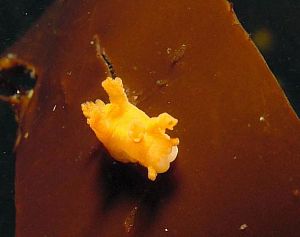
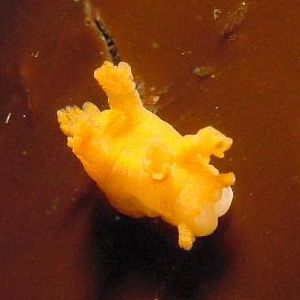
Hi,
Any chance someone can give me a name for this species of nudibranch. I've never seen anything like it before. Even a family for me to research would be helpful.
It was photographed at Langara Rocks in the Queen Charlotte Islands, British Columbia, Canada.
Approx 1/2" on bull Kelp near surface.
Thankyou.
Andy Murch
andymurch@scubadiving.com
Murch, A., 2001 (Jul 8) Nudibranch from British Columbia. [Message in] Sea Slug Forum. Australian Museum, Sydney. Available from http://www.seaslugforum.net/find/4783Dear Andy,
It's a bit hard to be sure from the angle of the photo juat what the shape of the animal is, but it looks like it could possibly be related to Scyllaea pelagica and Notobryon wardi, two dendronotoideans which live on kelp, feeding on attached hydroid colonies. It appears to have raised rhinophore pockets with crenulate lips, and the pair of flattened 'parapodia?' 'flaps?' about halfway down the body are similar to the parapodia of those two species and the third member of the family Scyllaeidae, which is Crosslandia viridis.
Any other photos, perhaps showing a side view would be helpful,
Best wishes,
Bill Rudman
